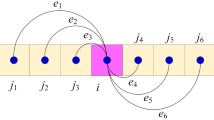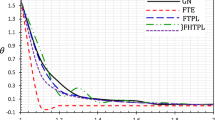Abstract
This study presents a peridynamic (PD) modeling approach for non-Fourier heat conduction and non-Fickian moisture concentration in a finite element framework by considering MATRIX27 elements native to ANSYS. The thermal and moisture fields are coupled in the form of Dual-Phase-Lag (DPL) models to resolve the issue of propagation of thermal wave and mass of moisture with infinite speed. The nonlocal effects arising from thermal inertia, moisture inertia and microstructural interaction are included through the PD form of coupled thermal and moisture field equations. The nonlocal PD theory involves integral equations without smoothness requirement of the field variable. The PD thermal and hygro bonds enable the exchange of thermal energy and moisture concentration between nodes. The efficacy of this approach is established by considering heat conduction in a nanoscale metal film and a plate with an insulated crack, and a bar of homogeneous and nonhomogeneous material subjected to sudden pulse of coupled thermal and moisture conditions.























Similar content being viewed by others
References
Sobolev SL (1994) Equations of transfer in non-local media. Int J Heat Mass Transf 37(14):2175–2182
Chen Z, Akbarzadeh A (2020) Advanced thermal stress analysis of smart materials and structures. Springer, Berlin
Cattaneo C (2011) Sulla conduzione del calore. In: Pignedoli A (eds) Some aspects of diffusion theory. C.I.M.E. Summer Schools, vol 42. Springer, Berlin, pp 485–485
Vernotte P (1958) Les paradoxes de la theorie continue de l’equation de la chaleur. Comptes Rend Acad Bulgare Sci 246:3154–3155
Tzou DY (1995) The generalized lagging response in small-scale and high-rate heating. Int J Heat Mass Transf 38(17):3231–3240
Tzou DY (1995) A unified field approach for heat conduction from macro-to micro-scales. J Heat Transfer 117(1):8–16
Akbarzadeh AH (2013) Multiphysical behaviour of functionally graded smart structures. In: Department of Mechanical Engineering, University of New Brunswick, Fredericton, NB, Canada
Silling SA (2000) Reformulation of elasticity theory for discontinuities and long-range forces. J Mech Phys Solids 48(1):175–209
Bobaru F, Duangpanya M (2010) The peridynamic formulation for transient heat conduction. Int J Heat Mass Transf 53(19–20):4047–4059
Oterkus S, Madenci E, Agwai A (2014) Peridynamic thermal diffusion. J Comput Phys 265:71–96
Oterkus S, Madenci E, Agwai A (2014) Fully coupled peridynamic thermomechanics. J Mech Phys Solids 64:1–23
Gerstle W, Silling S, Read D, Tewary V, Lehoucq R (2008) Peridynamic simulation of electromigration. Comput Mater Continua 8(2):75–92
Oterkus S, Madenci E, Oterkus E, Hwang Y, Bae J, Han S (2014) Hygro-thermo-mechanical analysis and failure prediction in electronic packages by using peridynamics. In: 2014 IEEE 64th electronic components and technology conference (ECTC) (pp 973–982), IEEE
Oterkus S, Fox J, Madenci E (2013) Simulation of electro-migration through peridynamics. In: 2013 IEEE 63rd electronic components and technology conference (pp 1488–1493), IEEE
Madenci E, Oterkus E (2014) Peridynamic theory and its applications. Springer, New York
Madenci E, Barut A, Dorduncu M (2019) Peridynamic differential operator for numerical analysis. Springer International Publishing, Berlin
Wang L, Xu J, Wang J (2018) A peridynamic framework and simulation of non-Fourier and nonlocal heat conduction. Int J Heat Mass Transf 118:1284–1292
Diyaroglu C, Oterkus S, Oterkus E, Madenci E, Han S, Hwang Y (2017) Peridynamic wetness approach for moisture concentration analysis in electronic packages. Microelectron Reliab 70:103–111
Xue Z, Tian X, Liu J (2020) Hygrothermoelastic response in a hollow cylinder considering dual-phase-lag heat-moisture coupling. Z Angew Math Phys 71(1):1–16
Madenci E, Barut A, Futch M (2016) Peridynamic differential operator and its applications. Comput Methods Appl Mech Eng 304:408–451
Madenci E, Dorduncu M, Barut A, Futch M (2017) Numerical solution of linear and nonlinear partial differential equations using the peridynamic differential operator. Numer Methods Part Differ Equ 33:1726–1753
Macek RW, Silling SA (2007) Peridynamics via finite element analysis. Finite Elem Anal Des 43(15):1169–1178
Madenci E, Oterkus S (2016) Ordinary state-based peridynamics for plastic deformation according to von Mises yield criteria with isotropic hardening. J Mech Phys Solids 86:192–219
ANSYS.2 (2017) Mechanical User’s Guide.
Diyaroglu C, Madenci E, Phan N (2019) Peridynamic homogenization of microstructures with orthotropic constituents in a finite element framework. Compos Struct 227:111334
Brorson SD, Fujimoto JG, Ippen EP (1987) Femtosecond electronic heat-transport dynamics in thin gold films. Phys Rev Lett 59(17):1962
Qiu TQ, Tien CL (1994) Femtosecond laser heating of multi-layer metals—I. Analysis. Int J Heat Mass Transfer 37(17):2789–2797
Acknowledgements
This study was performed as part of the ongoing research at the MURI Center for Material Failure Prediction through Peridynamics at the University of Arizona (AFOSR Grant no. FA9550-14-1-0073)
Author information
Authors and Affiliations
Corresponding author
Additional information
Publisher's Note
Springer Nature remains neutral with regard to jurisdictional claims in published maps and institutional affiliations.
Rights and permissions
About this article
Cite this article
Anicode, S.V.K., Madenci, E. Peridynamic modeling of dual-phase-lag thermal-moisture coupling in a finite element framework. Engineering with Computers 39, 911–923 (2023). https://doi.org/10.1007/s00366-022-01698-3
Received:
Accepted:
Published:
Issue Date:
DOI: https://doi.org/10.1007/s00366-022-01698-3




